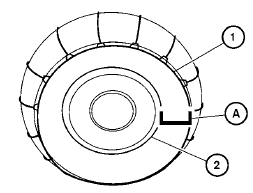Tire chains
CAUTION
Only certain SAE class “S” tire chains can be used on this vehicle. Using the wrong Class “S” chains on this vehicle will cause damage to the vehicle. If you plan to use tire chains/cables, you should use a tire chain that meets the minimum clearances for your vehicle.

Use of tire chains may be prohibited according to location. Check the local laws before installing tire chains. When installing tire chains, make sure they are the proper size for the tires on your vehicle and are installed according to the chain manufacturer’s suggestions. Use a tire chain that is designed to provide the specified space A between the installed tire chain 1 and where the tire meets the rim 2 as shown on the chart.

A tire chain that provides the specified amount of space will provide the necessary clearance between the tire and the closest vehicle suspension or body component. The minimum clearances are determined using the factory-equipped tires.
Other types may damage your vehicle. Use chain tensioners when recommended by the tire chain manufacturer to ensure a tight fit. Loose end links of the tire chain must be secured or removed to prevent the possibility of whipping action damage to the fenders or underbody. If possible, avoid fully loading your vehicle when using tire chains. In addition, drive at a reduced speed. Otherwise, your vehicle may be damaged and/or vehicle handling and performance may be adversely affected.
Tire chains must be installed only on the front wheels and not on the rear wheels.
Never install tire chains on a TEMPORARY USE ONLY spare tire.
Do not use tire chains on dry roads. Driving with tire chains in such conditions can cause damage to the various mechanisms of the vehicle due to some overstress.
See also:
Gasoline specifications
NISSAN recommends using gasoline that meets
the World-Wide Fuel Charter (WWFC) specifications
where it is available. Many of the automobile
manufacturers developed this specification
to improve em ...
Luggage hooks (if so equipped)
Luggage hooks (if so equipped)
- Always make sure that the luggage
is properly secured. Use the suitable
ropes and hooks.
- Unsecured luggage can become
dangerous in an accident or sudde ...
Drive belt
QR25DE engine
1. Power steering fluid pump pulley
2. Water pump pulley
3. Generator
4. Air conditioner
5. Crankshaft pulley
6. Drive belt Automatic tensioner
WARNING
Be sure the ignition swi ...
